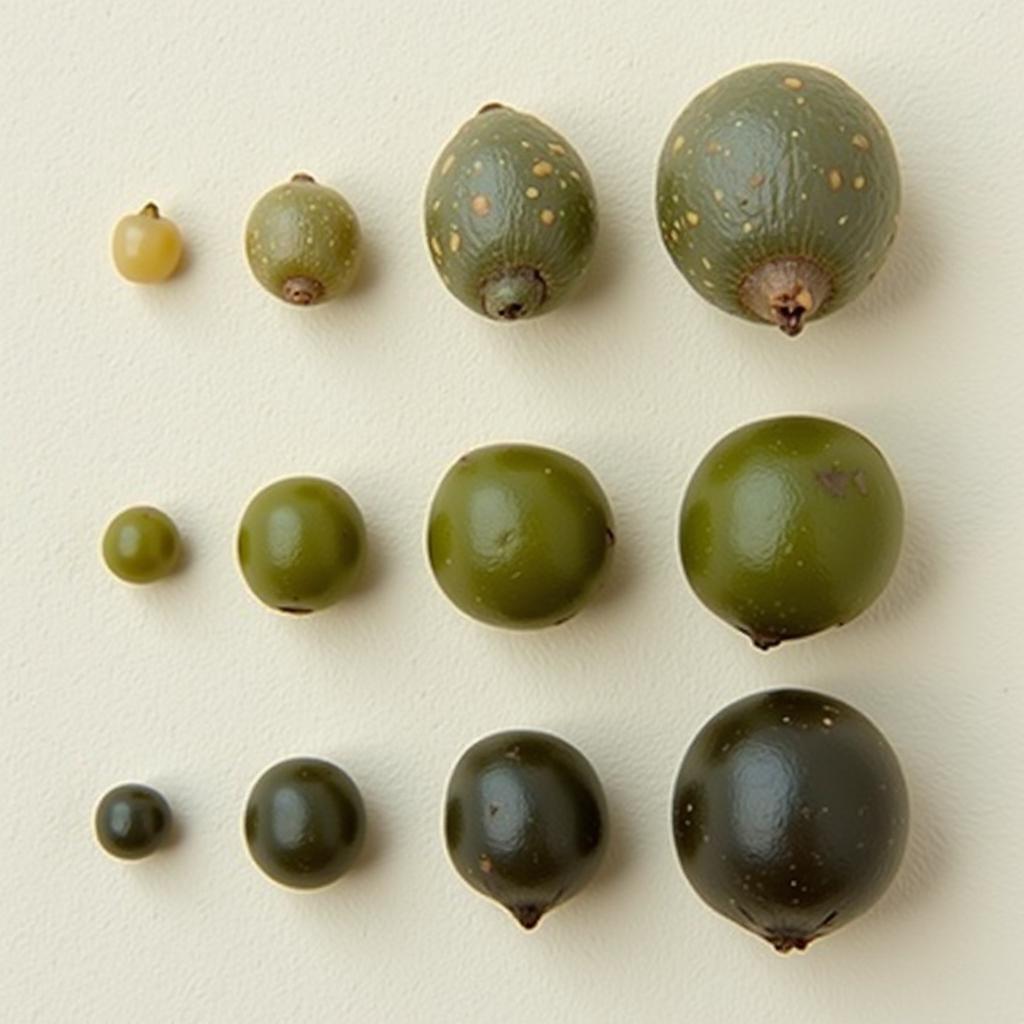Capers, those tiny, briny buds, add a burst of flavor to a variety of dishes. But what color is caper, exactly? While most people envision them as a simple green, the truth is a bit more nuanced. The color of capers ranges from a dark olive green to a subtle, muted grayish-green, and even sometimes bordering on a brownish-green, depending on the size, variety, and processing method. Let’s dive deeper into the captivating world of caper color and discover its fascinating variations.
Exploring the Color Spectrum of Capers
The color of capers isn’t a static shade. Several factors influence their final hue, creating a subtle spectrum of greens. Smaller capers, often prized for their intense flavor, tend to be a darker, more vibrant green. Larger capers, while milder in taste, often exhibit a lighter, more subdued green, sometimes with grayish or brownish undertones. The variety of caper plant also plays a role, with some varieties naturally producing darker or lighter fruits.
 Caper Color Variations: From Dark Olive Green to Grayish-Brown
Caper Color Variations: From Dark Olive Green to Grayish-Brown
Processing methods significantly impact caper color. Capers are typically cured in either brine (saltwater) or vinegar. Brine-cured capers often maintain a deeper, more olive-green color. Vinegar-cured capers, on the other hand, can appear slightly duller or more brownish-green. The duration of curing can also affect the color intensity.
What Influences Caper Color? Size, Variety, and Curing Methods
The size of a caper is a key determinant of its color. Think of it like this: the smaller and younger the bud, the more concentrated the chlorophyll, resulting in a richer, deeper green. As capers mature and grow larger, the chlorophyll becomes less concentrated, leading to a lighter, more muted green. This is why nonpareil capers, the smallest variety, are typically the darkest green.
The variety of caper plant also contributes to color variations. While most caper plants produce green buds, some varieties may lean towards a naturally lighter or darker shade of green. Similar to how different apple varieties yield different shades of red and green, caper varieties exhibit subtle color differences due to their genetic makeup. Understanding these varietal distinctions can help you predict the expected color of your capers.
How Does Curing Affect Caper Color?
Curing methods are a major factor in the final color of capers. Brine-curing, the most common method, involves submerging the capers in a saltwater solution. This method tends to preserve the natural green color of the capers, resulting in a deep, olive-green hue. Vinegar-curing, while less common, involves preserving capers in vinegar. This process can sometimes lead to a slight browning or dulling of the green color, giving the capers a slightly more muted or grayish-green appearance.
Caper Color in Culinary Applications: From Garnishes to Sauces
The color of capers, while subtle, can play a role in their culinary applications. Their deep green hue provides a visual pop against lighter-colored dishes, making them an excellent garnish. In sauces, capers contribute not only flavor but also a subtle hint of color, enhancing the overall visual appeal of the dish. Just as the color of a dogwood tree enhances the landscape, the subtle green of capers adds a touch of visual interest to culinary creations.
In conclusion, the color of a caper is not simply green. It’s a complex interplay of size, variety, and curing methods that results in a nuanced spectrum of green hues. From the dark, vibrant green of small, brine-cured capers to the lighter, more muted tones of larger, vinegar-cured ones, understanding the factors influencing caper color allows you to appreciate the depth and complexity of this culinary gem.
FAQ
- Are all capers green? Yes, capers are typically green, ranging from dark olive to a lighter, grayish-green.
- Why are some capers darker than others? Smaller capers and brine-cured capers tend to be darker green.
- Do vinegar-cured capers have a different color? Yes, they can be slightly more brownish or muted green compared to brine-cured capers.
- Does the color of a caper affect its flavor? While color can sometimes indicate size, and size affects flavor intensity, color itself doesn’t directly impact taste.
- Are brown capers spoiled? Not necessarily. Some capers naturally have a brownish hue, particularly larger ones or those cured in vinegar.
- Can I use different colored capers interchangeably? Yes, you can generally use different colored capers interchangeably, although the size might impact flavor intensity.
- Where can I learn more about capers? Explore more about capers and their culinary uses by visiting what color is a dogwood tree.
Need help choosing the perfect paint color for your next project? Contact us at 0373298888, email us at [email protected], or visit us at 86 Cầu Giấy, Hà Nội. Our 24/7 customer service team is ready to assist you.

